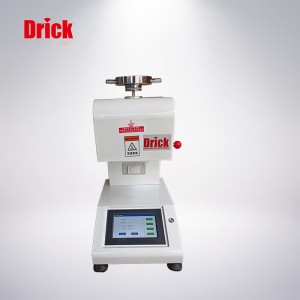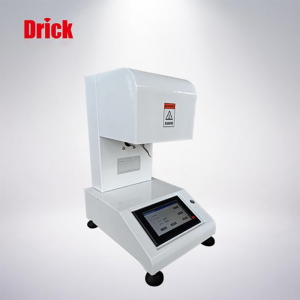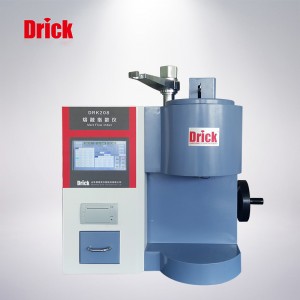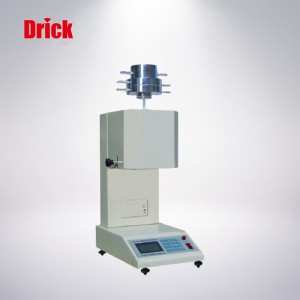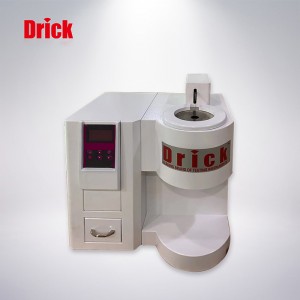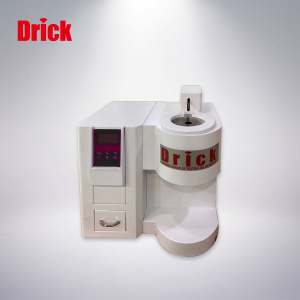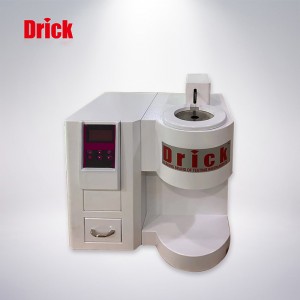DRK208 Melt Flow Rate Tester
The DRK208 melt flow rate tester is an instrument for measuring the flow properties of plastic polymers at high temperatures according to the test method of GB3682-2018. It is used for polyethylene, polypropylene, polyoxymethylene, ABS resin, polycarbonate, nylon fluoroplastics, etc. Measurement of melt flow rate of polymer at high temperature. It is suitable for production and research in factories, enterprises and scientific research units.
Main Features:
1. Extrusion part:
Diameter of the discharge port: Φ2.095±0.005 mm
The length of the discharge port: 8.000±0.005 mm
Diameter of charging cylinder: Φ9.550±0.005 mm
Length of charging barrel: 160±0.1 mm
Piston rod head diameter: 9.475±0.005 mm
Piston rod head length: 6.350±0.100mm
2. Standard test force (level eight)
Level 1: 0.325 kg = (piston rod + weight tray + heat insulation sleeve + 1 weight body)
=3.187N
Level 2: 1.200 kg=(0.325+0.875 weight No. 2)=11.77 N
Level 3: 2.160 kg = (0.325 + No. 3 1.835 weight) = 21.18 N
Level 4: 3.800 kg=(0.325+No. 4 3.475 weight)=37.26 N
Level 5: 5.000 kg = (0.325 + No. 5 4.675 weight) = 49.03 N
Level 6: 10.000 kg=(0.325+No. 5 4.675 weight + No. 6 5.000 weight)=98.07 N
Level 7: 12.000 kg=(0.325+No. 5 4.675 weight+No. 6 5.000+No. 7 2.500 weight)=122.58 N
Level 8: 21.600 kg=(0.325+No. 2 0.875 weight+No. 3 1.835+No. 4
3.475+No.5 4.675+No.6 5.000+No.7 2.500+No.8 2.915 weight)=211.82 N
The relative error of weight mass is ≤0.5%.
3. Temperature range: 50-300℃
4. Constant temperature accuracy: ±0.5℃.
5. Power supply: 220V±10% 50Hz
6. Working environment conditions: the ambient temperature is 10℃-40℃; the relative humidity of the environment is 30%-80%; there is no corrosive medium around, no strong air convection; no vibration around, no strong magnetic interference.
7. External dimensions of the instrument: 250×350×600=(length×width×height)
Structure and working principle:
DRK208 melt flow rate tester is an extruded plastic meter. It uses a high-temperature heating furnace to make the measured object reach a molten state under the specified temperature condition. The test object in this molten state is subjected to an extrusion test through a small hole of a certain diameter under the load gravity of a prescribed weight. In the plastic production of industrial enterprises and the research of scientific research units, the “melt (mass) flow rate” is often used to express the physical properties of polymer materials in the molten state such as fluidity and viscosity. The so-called melt index refers to the average weight of each section of the extrudate converted into the extrusion volume of 10 minutes.
Melt (mass) flow rate meter is expressed by MFR, the unit is: grams/10 minutes (g/min), and the formula is expressed by: MFR (θ, mnom)
=tref .m/t
In the formula: θ—— test temperature
mnom— nominal load Kg
m —— the average mass of the cut g
tref —— reference time (10min), S (600s)
t —— cut off time interval s
This instrument is composed of a heating furnace and a temperature control system and is installed on the base of the body (column).
The temperature control part adopts the single-chip microcomputer power and temperature control method, which has strong anti-interference ability, high temperature control accuracy, and stable control. The heating wire in the furnace is wound on the heating rod according to a certain rule to minimize the temperature gradient to meet the standard requirements.
Precautions:
1. The single power socket must have a grounding hole and be reliably grounded.
2. If an abnormal display appears on the LCD, turn it off first, then reset the test temperature after turning it on, and start work.
3. During normal operation, if the furnace temperature is greater than 300°C, the software will protect it, interrupt heating, and send out an alarm.
4. If an abnormal phenomenon occurs, such as the temperature cannot be controlled or displayed, etc., it should be shut down and repaired.
5. When cleaning the piston rod, do not scrape with hard objects.
Note: Due to technological progress, the information will be changed without notice. The product is subject to the actual product in the later period.
Products categories
-

Phone
-

E-mail
-

Whatsapp
-

Top


